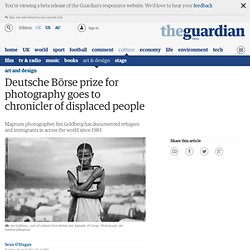

Les 10 photos les plus chères au monde. Focus Publié le 10 juillet 2009 | par pixfan La liste présente un classement du prix le plus élevé payé pour une photographie. 1. Andreas Gursky, 99 Cent II Diptychon (2001) vendu 3 346 456$ en février 2007 lors d’une vente aux enchères chez Sotheby’s à Londres. 2. 3. 4. 5. 6. 7. 8. 9. 10. Via : Wikipédia Tags: andreas gursky, ansel adams, edward steichen the pond moonlight, edward weston, gustave le gray, moonrise hernandez new mexico, richard prince untitled cowboy, robert mapplethorpe A propos de l'auteur pixfan Depuis juillet 2006, Pixfan traite de l’actualité de la photographie : expositions, astuces et découvertes de photographes connus ou en devenir. Photography Books of 2007. Deutsche Börse prize for photography goes to chronicler of displaced people.
Jim Goldberg has won this year's £30,000 Deutsche Börse prize for photography, in a ceremony hosted by the Photographers' Gallery in London.

The Magnum photographer, who has documented the experiences of refugees, immigrants and displaced people from Africa, the Middle East and eastern Europe since 1983 in a project titled Open See, triumphed over a shortlist that included fine art photographer Thomas Demand, whom many insiders considered the favourite. Goldberg, who lives in San Francisco, and won the 2007 Cartier- Bresson Prize for an earlier version of the same project, describes himself as a documentary storyteller.
Open See was shown to great acclaim at the Photographers' Gallery last year. It features polaroids, video stills, found images and hand-written text often using the words of his subjects. The chair of the jury, Brett Rogers, praised Goldberg's "timely and inventive approach to documentary practice … allowing these individuals to tell their own stories. " Wear Good Shoes: Advice to young photographer.
3 procès en droit à l'image. LE MONDE | • Mis à jour le | Par Michel Guerrin Trois procès pour un seul livre, c'est rare.

Et inédit pour un livre d'art. Dans Perdre la tête, publié en octobre 2005 chez Gallimard, François-Marie Banier associe, dans une sorte de comédie humaine, des portraits photographiques de gens connus, comme l'acteur Daniel Emilfork ou l'ethnologue Claude Lévi-Strauss, mais aussi d'anonymes et de marginaux.
Le droit à l'image est au centre de ces procès. Trois personnes, identifiables dans Perdre la tête, contestent en justice la publication de leur photo devant le tribunal de grande instance de Paris. La première affaire concerne le portrait d'une femme assise sur un banc public, à Paris, en train de téléphoner avec son portable, et tenant son chien en laisse. Pour le juge, "seule une publication contraire à la dignité de la personne ou revêtant pour elle des conséquences d'une particulière gravité" induit la prééminence du droit à l'image.
Mais, pour Laurent Merlet, avocat de M. The Tennis Girl. If a single picture ever conveyed the sexual liberation, permissive society and hostility towards norms and authorities of the 1970s, it would be the iconic poster of “The Tennis Girl”.
Taken at the end of the long hot summer in September 1976, the photo was not an accidental shot. Martin Elliot, then a photography student in Birmingham, asked his then girlfriend, 18-year old Fiona Butler to borrow a tennis dress, a racket and balls and to pose for him. Martin’s photo of Fiona lifting her dress and revealing that she was not wearing underwear is perhaps tame by today’s standards, but when he sold it to poster chain Athena, which published as part of the calendar for the Queen’s 1977 Silver Jubilee, it caused a sensation. Critics dismissed it a “schoolboy’s fantasy”, while Elliott himself said, “it is not a picture I would buy”, for it had only the appeal of a voyeuristic postcard. But it didn’t deter hundreds of thousands of schoolboys to grace their bedroom walls with it. Like this: A well-deserved break.